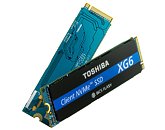- Joined
- Oct 9, 2007
- Messages
- 47,941 (7.37/day)
- Location
- Dublin, Ireland
| System Name | RBMK-1000 |
|---|---|
| Processor | AMD Ryzen 7 5700G |
| Motherboard | Gigabyte B550 AORUS Elite V2 |
| Cooling | DeepCool Gammax L240 V2 |
| Memory | 2x 16GB DDR4-3200 |
| Video Card(s) | Galax RTX 4070 Ti EX |
| Storage | Samsung 990 1TB |
| Display(s) | BenQ 1440p 60 Hz 27-inch |
| Case | Corsair Carbide 100R |
| Audio Device(s) | ASUS SupremeFX S1220A |
| Power Supply | Cooler Master MWE Gold 650W |
| Mouse | ASUS ROG Strix Impact |
| Keyboard | Gamdias Hermes E2 |
| Software | Windows 11 Pro |
Toshiba today introduced the XG6 series SSDs. Built in the M.2-2280 form-factor with PCI-Express 3.0 x4 interface, the drives take advantage of the NVMe 1.3a protocol, and succeed the XG5 series from 2017. The drives implement Toshiba's new 96-layer 3D TLC NAND flash dubbed BiCS Flash, which went into mass-production in Q1-2018. Available in 256 GB, 512 GB, and 1 TB capacities, the drives offer sequential transfer rates of up to 3,180 MB/s reads, with up to 2,960 MB/s writes. Also on offer are 4K random access transfer rates of up to 355,000 IOPS reads, with up to 365,000 IOPS writes. The drives are expected to be backed by 5-year warranties, when they go on sale at prices competitive with the likes of Samsung's 970 EVO series.


View at TechPowerUp Main Site


View at TechPowerUp Main Site




